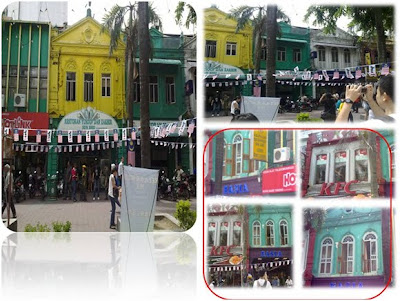1.Embrace of the future
The world's tallest twin building,The Petronas Twin Towers was designed by Argentinian architect Cesar Pelli. The architecture of Kuala Lumpur is a blend of old colonial influences, Asian traditions, Malay Islamic inspirations, modern and post modern mix.. These buildings have Moorish, Tudor, Neo-Gothic or Grecian-Spanish style or architecture. Most of the styling have been modified to cater to use local resources and the acclimatized to the local climate, which is hot and humid all year around. Independence coupled with the rapid economic growth from the 70's to the 90's, allows buildings with more local and Islamic motif arise in the middle of the city. Many of these buildings derive their design from traditional Malay items such as the head dress and the keris. Some of these buildings have Islamic geometric motifs integrated with the designs of the building. Buildings with all glass shell appears around the city, with the most prominent example being the Petronas Twin Towers.
2. Freezing of the Past
Shophouses along Jalan Hang Kasturi pedestrian mall are mostly Neo-classical structures. A particularly fine example is the block of shophouses at No 32-52, built around 1909. Alternating roofline and window shapes link these two-storey buildings. When Central Market was a market selling fresh produce, the Jalan Hang Kasturi shops played a complementary role, retailing such goods as dried fish and preserved vegetables. Many of the dry goods stores still remain.
3.Transition between the Past and the Present
Central Market is located at Jalan Hang Kasturi, It was built in 1888 and originally used as a wet market. It has since been classified as a Heritage Site by the Malaysian Heritage Society and it is now a landmark for Malaysian culture and heritage. It is also strategically located within public transport facilities. As Kuala Lumpur experienced its own development at a rapid pace in the 1970s, there were plans to demolish the site. The intervention of the Malaysian Heritage Society proved timely as they successfully petitioned against its deconstruction and the site was declared as a 'Heritage Site'. Saved from demolition, the original 1936 Central Market was converted into a " festive hall " and in 1986, reopened as the country's foremost Cultural Shopping Centre showcasing the finest local crafts in the country.
4.Cultural Crossroads
Petaling Street,The original Chinatown centred on Market Square. High Street, now known as Jalan Tun H.S. Lee, became increasingly popular as it was higher than the rest of the town and therefore less prone to floods. The wealthier and more ornate shop houses were built north of Jalan Cheng Lock, closer to the business centre. Kuala Lumpur was a typical "pioneer" town at the turn of the century, filled with a rough and tough population that was largely male. They were largely Cantonese and Hakkas who came to the city because of the tin trade, working as coolies in the mines. Petaling Street however does not exclusively offer pirated products. Haggling is a common sight here and the place is usually crowded with locals as well as tourists. Traders here are mainly Chinese but there are also Indian, Malay, and Bangladeshi traders.
5. Collapsing Identity
(Shophouses Along Jalan Tun HS Lee)(Roger Street)
The identity of the design and purpose of the building is lost. Nothing much has happened since the Annexe except that part of Jalan Hang Kasturi has been converted into a pedestrian walk. Many of the original businesses that were supplementary to the businesses in the wet market have moved away. The current operators are not necessarily what can be called 'tourist attractions'. This seems to be the only business carried over from the old days...





No comments:
Post a Comment